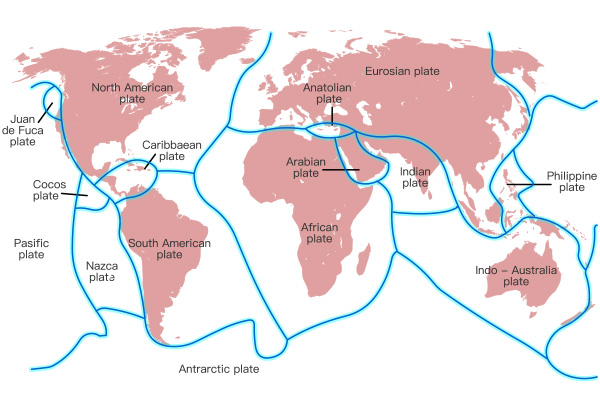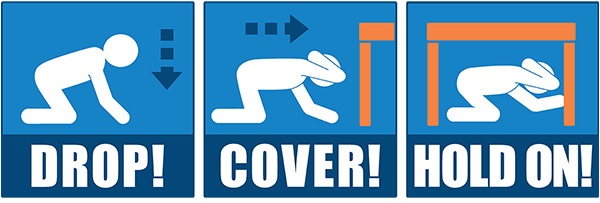Earthquake Facts & Dispelling Earthquake Myths
Today we know a lot about what causes earthquakes and how to protect ourselves from earthquake damage. But there are still a lot of myths and misunderstandings about earthquakes. In this blog post, we’ll debunk some of the most common—and most dangerous—earthquake myths, empowering you to separate fact from fiction so you can protect yourself and your family from earthquake hazards.
Myth #1: Earthquakes only happen in certain parts of the world
While it's true that there are more earthquakes in some parts of the world than in others, one of the most common earthquake myths is that they only happen along tectonic plate boundaries. It’s not true!
Plate boundaries, or faults, are areas where the Earth’s tectonic plates meet. There are three types of earthquake faults, including:
- Convergent boundaries: These plate boundaries form where two tectonic plates move towards each other and collide. They often have intense seismic activity, and one of the world’s most seismically active convergent boundaries is along the Pacific Ring of Fire.
- Divergent boundaries: These boundaries form where two tectonic plates move away from each other. Earthquakes, and especially volcanic activity, are common along these boundaries. The Mid-Atlantic Ridge and the East African Rift Zone are examples of famous divergent plate boundaries.
- Transform boundaries: These boundaries occur where two tectonic plates slide past each other, rubbing along their edges. California’s San Andreas fault is one of the world’s most famous, and seismically active, transform boundaries.
However, earthquakes don’t only occur along plate boundaries - they can also happen within the tectonic plates themselves! These types of earthquakes are called “intraplate earthquakes,” and they can strike even in seismically stable areas.
To find out about the earthquake risk near you, be sure to read our blog post on earthquake probabilities.
Myth #2: Animals can predict earthquakes
One of the most common myths about earthquakes is that animals can predict them. This myth is fueled by anecdotal reports and observations, but there is no conclusive scientific evidence to support this.
While some animals may show unusual behavior before an earthquake, such as changes in their activity, the USGS Earthquake Hazards Program explains that it’s unlikely that animals can actually predict earthquakes, writing “consistent and reliable behavior prior to seismic events, and a mechanism explaining how it could work, still eludes us.” Translation: animals don’t always behave differently before a quake, and we can’t think of any way that animals would be able to detect them ahead of time.
Myth #3: Earthquakes only occur during certain seasons
Some people believe that seismic activity only happens during specific seasons or times of the year, but this myth isn’t backed up by science.
One of the most important and interesting facts to know about earthquakes is that they can happen at any time. Since earthquakes are driven by tectonic forces, which operate independently of the seasons, there is simply no such thing as earthquake season.
In fact, extensive studies and long-term seismic monitoring have consistently shown that earthquakes happen randomly throughout the year without any seasonal patterns.
Along these same lines, there’s also no scientific basis for the belief in “earthquake weather.”
Side note: because earthquakes can happen at any time, you should look into retrofitting your home ASAP!
Myth #4: You should stand in a doorway during an earthquake
Experts have widely debunked the myth that standing in a doorway is the safest place to ride out an earthquake.
In the past, doorways were considered one of the strongest parts of a building's structure, leading to the idea that they may offer greater protection from earthquakes. However, modern building codes and construction have significantly improved the structural integrity of all parts of buildings, meaning that doorways are no safer than other areas.
The most important earthquake safety tip we can share is to simply "Drop, Cover, and Hold On” during an earthquake. This is the best way to protect yourself from hazards, such as objects that may fall off shelves and heavy items that may tumble down during earthquake shaking.
Myth #5: Small earthquakes mean a bigger one is coming
Earthquakes can range in size from barely noticeable tremors to incredibly scary and damaging natural disasters. But do small earthquakes always mean that a bigger one is coming soon? In short, no.
While small earthquakes can sometimes happen before bigger earthquakes, this pattern does not always happen. Even when a region is hit by a cluster of small earthquakes, that doesn’t always mean that a big earthquake will hit next.
Still, if an earthquake strikes, it is important to be prepared to Drop, Cover, and Hold On during that earthquake as well as during any potential aftershocks. Practicing these safety steps ahead of time will help you become more prepared to react when an earthquake strikes.
Myth #6: Earthquakes are caused by a giant catfish!
According to ancient Japanese mythology, a giant catfish called Namazu is responsible for earthquakes. The legend says that Namazu lives under the islands of Japan and is guarded by a god, who restrains the catfish with a large rock.
But from time to time, Namazu thrashes about, wiggling his giant tail, and that causes violent earthquakes. Although pictures of Namazu date back to the 15th century, there has been no scientific evidence to corroborate a giant, quake-causing catfish.
Myth #7: Opening windows can prevent building collapse
Opening windows will not prevent a building from collapsing. In fact, it might create even more danger due to broken glass and/or falling debris. Remember, during an earthquake, don’t attempt to open any windows, but simply Drop, Cover, and Hold On. This is the best way to protect yourself from earthquake-related injuries.
Myth #8: Houses can completely protect you during an earthquake
One of the most dangerous and yet most common myths about earthquakes is that houses can provide complete protection. While well-designed and properly built residences can offer some safety, no home can guarantee total protection from damaging earthquakes.
In fact, earthquakes can cause structural damage, release hazardous materials from within homes, and even knock buildings down completely. Even new homes built according to the latest seismic codes may have weak points that could be compromised by a strong earthquake.
If an earthquake hits, make sure to Drop, Cover, and Hold On first, and then, after the ground stops shaking, follow your evacuation plan. And don’t forget to grab your earthquake preparedness kit on your way out the door.
Myth #9: The Richter scale measures damage caused by earthquakes
The Richter scale does not tell you how much damage an earthquake caused. What it really describes is how powerfully the quake shook the ground. However, this scale does not consider things like, is the ground muddy, sandy, or rocky? Different types of land will shake more or less powerfully during the same earthquake, so this and other factors are important to consider if you want to really understand how powerful an earthquake was or how much damage it might cause.
Developed by seismologist Charles F. Richter in the 1930s, one fun (but scary!) earthquake fact is that each whole number on the scale means a 32x increase in the amount of energy released by an earthquake!
What this means is that, measured by the Richter scale:
- A magnitude 5 earthquake releases 32 times more energy than a magnitude 4 earthquake
- A magnitude 6 earthquake releases about 1,000 times (32x32) more energy than a magnitude 4 earthquake
- A magnitude 7 earthquake releases about 32,000 times (32x32x32) more energy than a magnitude 4 earthquake
- A magnitude 8 earthquake releases just over 1,000,000 times (32x32x32x32) more energy than a magnitude 4 earthquake
These days, to describe how big an earthquake was, scientists usually use the “Moment Magnitude Scale” instead of the Richter Scale. This newer measure tells us how powerful a quake was by looking at things like how strong the rocks are where the quake happened, how big the part of the Earth’s crust that moved was, and how far it moved. It is more accurate for larger earthquakes than how Richter magnitudes are determined.
Conclusion: Stay Safe During an Earthquake and Prepare
Now that you know about the most common earthquake misconceptions, you should be able to tell the difference between potentially dangerous earthquake myths and facts.
To protect yourself and your family from earthquake damage, be prepared, follow established safety guidelines, and be sure to create an evacuation plan, as well as your own fully-stocked earthquake emergency kit.
Remember—earthquake preparedness saves lives! Visit our blog for tips, advice, and more information about earthquakes.




